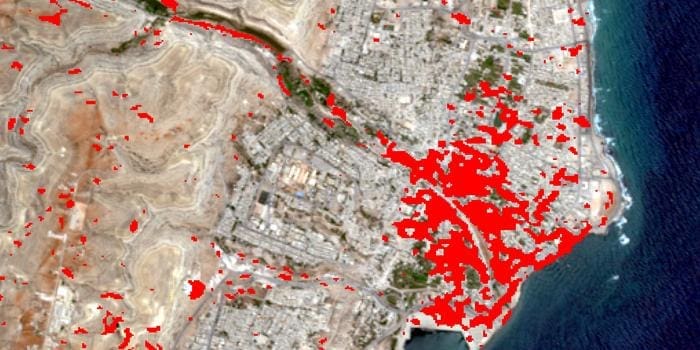A new study from the University of Southern California (USC) Viterbi School of Engineering, in collaboration with the University of Paris Cité, has revealed a rising and unexpected danger in desert regions: flooding. Research shows that worsening soil erosion in coastal areas due to desertification is amplifying the destructive power of floods, particularly in Middle Eastern and North African cities.
The study, published in Nature Communications, closely examines the 2023 floods in Derna, Libya, which claimed over 11,300 lives. Researchers link the severity of these floods to increased soil erosion, warning that such events may become more frequent due to climate change.

Desertification and flooding: a dangerous combination
In the past decade, the North African Sahara has been experiencing increasingly extreme conditions: prolonged droughts followed by intense coastal rainstorms. These shifts are fueled by desertification and rising seawater temperatures in the Eastern Mediterranean caused by global warming.
Essam Heggy, a research scientist at USC Viterbi and co-principal investigator at the USC Viterbi Center for Arid and Water Research Exploration (AWARE), explained that these combined forces are accelerating soil erosion, contributing to deadly mudflows that overwhelmed aging dams in the region.
While droughts are often considered the most pressing threat in desert regions, Heggy and his co-authors argue that flooding poses an even greater risk. The study, titled ‘Assessing Flash Flood Erosion Following Storm Daniel in Libya’, provides evidence for this claim by examining the devastating floods that followed “Medicane Daniel” (Storm Daniel) in September 2023.
The Libyan disaster: a century’s deadliest flood
Storm Daniel struck eastern Libya in the fall of 2023. The resulting flash floods were among the deadliest in Africa in a century. The combination of unusually heavy rainfall, the collapse of two flood control dams, and the failure of water infrastructure left much of the city of Derna in ruins. According to Heggy’s research, sediment loading caused by surface erosion further amplified the disaster, as thickened, debris-laden floodwaters overwhelmed infrastructure in Derna and Susah, leading to severe damage across both cities.
Methodology and findings
To assess the flood’s impact, the research team used advanced technology, including Sentinel-1A C-band orbital Synthetic Aperture Radar images. These radar images allowed the researchers to measure changes in surface texture before and after the flood, serving as indicators of soil erosion and infrastructure damage.
The study found that the combination of eroded soils and heavy rainfall dramatically increased the destructive power of the floodwaters, contributing to the collapse of the dams intended to protect Derna. The current runoff flow models used in flood risk management fail to account for soil erosion in desert environments, Heggy notes, highlighting the need for more advanced monitoring tools.
Heggy stresses the importance of satellite technology in managing these risks. He believes that improved satellite monitoring of arid regions is crucial for mitigating the danger of future floods.
Jonathan Normand, a visiting graduate student at the USC AWARE Center and first author of the study, points out that while modern communication satellites are abundant, there is a shortage of satellites designed to track surface processes and soil erosion in desert regions: “Today, you can post on social media from the middle of a desert thanks to the hundreds of communication satellites now orbiting Earth. Yet, researchers are still left with a limited number of satellites to grasp the complexities of Earth’s dynamics and surface processes in deserts.”
Heggy and his colleagues warn in a parallel study that the Libyan disaster could be a precursor to similar events across North Africa and the Arabian Peninsula. Rising urban populations, combined with increasingly intense storms, leave many coastal desert cities vulnerable to future floods.
Climate change and policy failures
The authors emphasize that the floods in Derna demonstrate the inadequacy of current disaster preparedness measures in the Middle East and North Africa. Heggy points out the failure of regional policymakers to prioritize science-based disaster planning, despite hosting the last two global climate change conferences.
He warns that extreme weather events like the Derna floods are not isolated incidents and will become more frequent and severe as climate change progresses: “The deadliest enemy ahead is our own belief that these extremes are punctual events that will not repeat. Climate models tell us that they will hit back even stronger.”
This study serves as a reminder that desert regions, often thought to be immune to flooding, are now increasingly at risk due to global warming. As extreme weather patterns become more common, cities in desert environments must adapt to the growing threat posed by climate-induced floods.
Journal Reference:
Normand, J.C.L., Heggy, E., ‘Assessing flash flood erosion following storm Daniel in Libya’, Nature Communications 15, 6493 (2024). DOI: 10.1038/s41467-024-49699-8
Article Source:
Press Release/Material by University of Southern California
Featured image: Derna dam after collapse Credit: Ahmed.khalil12410 | CC BY 4.0 via Wikimedia Commons




